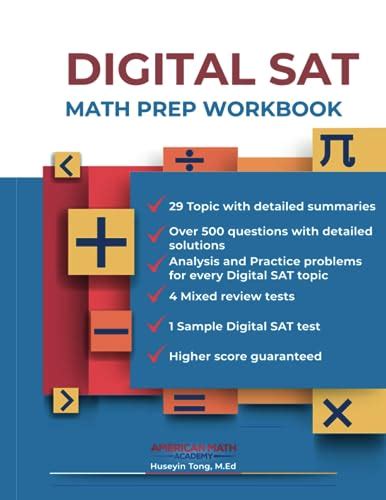Introduction

The SAT Math section is a critical component of the exam, testing students’ mathematical reasoning and problem-solving abilities. Preparing for this section effectively requires strategic planning and targeted practice. This guide provides comprehensive advice and strategies to help students maximize their SAT Math score.
Understanding the SAT Math Format
The SAT Math section consists of two main sections:
- Calculator Section: 38 questions, 70 minutes, use of a calculator permitted
- No Calculator Section: 20 questions, 25 minutes, no calculator allowed
Questions cover a range of topics, including:
- Algebra I: 25%
- Algebra II: 36%
- Geometry: 31%
- Trigonometry: 8%
Pain Points and Motivations
- Time constraints: Balancing speed and accuracy is crucial.
- Anxiety: Test-taking anxiety can hinder performance.
-
Lack of confidence: Doubts about one’s abilities can affect focus.
-
College admissions: A strong SAT Math score enhances college applications.
- Career opportunities: Math skills are essential for various professions.
- Personal growth: Mastery of math enhances problem-solving abilities and critical thinking.
Tips and Tricks
General Strategies:
- Practice regularly: Consistent practice builds familiarity and improves skills.
- Time management: Allocate time efficiently and avoid spending too much on any single question.
- Educated guessing: If unsure, make an educated guess rather than leaving a question unanswered.
- Eliminate incorrect options: Narrow down choices by eliminating options that are clearly wrong.
Calculator Section:
- Use the calculator wisely: Use the calculator for complex calculations, but avoid over-reliance.
- Estimate answers: Quick estimations can help avoid common traps in calculator-based questions.
- Check your work: Recalculate values using mental math to reduce errors.
No Calculator Section:
- Master mental math: Develop strong mental calculation skills for quick and accurate solutions.
- Use estimation techniques: Estimate values to approximate answers or eliminate incorrect options.
- Apply geometric principles: Visualize geometric shapes and use theorems to solve problems.
Practice and Preparation
- Official College Board materials: Use College Board’s official practice tests and questions.
- Third-party practice books: Supplement official materials with reputable practice books.
- Online resources: Utilize online platforms and apps for additional practice and personalized feedback.
- Tutoring and workshops: Seek guidance from qualified tutors or attend workshops to reinforce concepts.
Tables for SAT Math Success
Table 1: SAT Math Score Distribution
| Percentile | Score Range | Number of Questions Correct |
|---|---|---|
| 75th | 700-770 | 50-58 |
| 50th | 570-630 | 39-47 |
| 25th | 500-560 | 30-38 |
Table 2: Common SAT Math Trapped
| Trap | Description |
|---|---|
| Tricky wording | Questions that use ambiguous or misleading language |
| Negative values | Questions that introduce negative values without clear indication |
| Unit conversion | Questions that require converting units without providing necessary information |
| Unfamiliar notation | Questions that use unfamiliar or unconventional notation |
| Time management | Questions that are strategically placed to allocate time unwisely |
Table 3: SAT Math Score Improvement Strategies
| Strategy | Description |
|---|---|
| Focused practice | Targeting specific areas of weakness |
| Error analysis | Identifying and addressing common mistakes |
| Timed practice tests | Simulating test-like conditions to improve time management |
| Mental math proficiency | Developing strong mental calculation abilities |
| Expert guidance | Seeking assistance from qualified tutors or instructors |
Table 4: Pros and Cons of Different SAT Math Prep Methods
| Method | Pros | Cons |
|---|---|---|
| Online courses | Flexibility, personalized feedback, video lessons | Can be expensive, requires discipline |
| Tutoring | One-on-one attention, tailored instruction | Limited availability, can be costly |
| Practice books | Wide range of practice questions, affordable | Lacks personalized feedback, can be overwhelming |
| Classroom instruction | Structured environment, peer support | Rigid schedule, may not address individual needs |
| Self-study | Free, customizable schedule | Requires self-motivation, may lack expert guidance |
